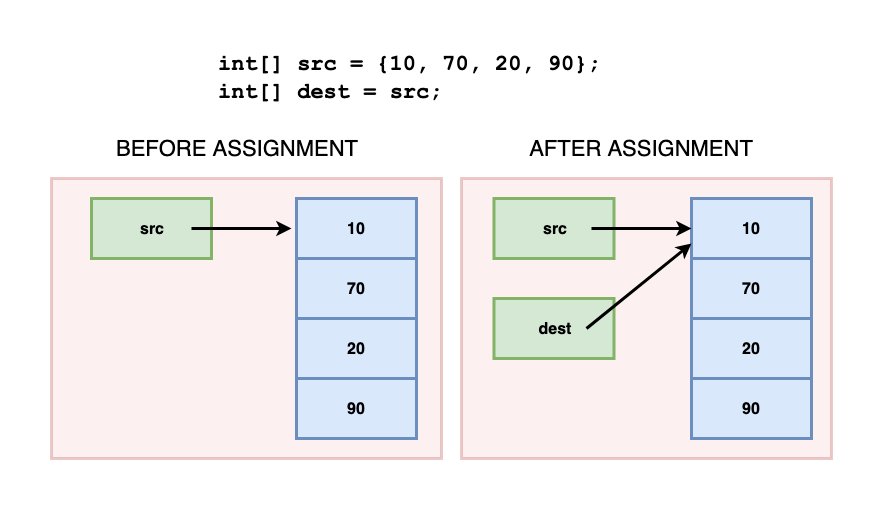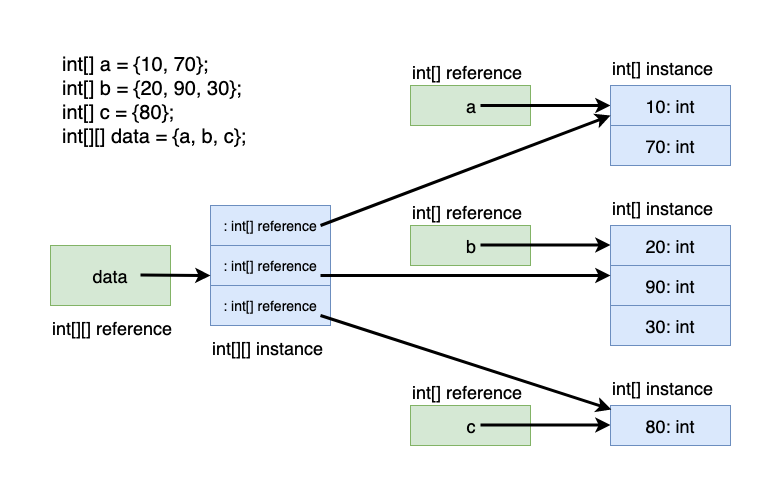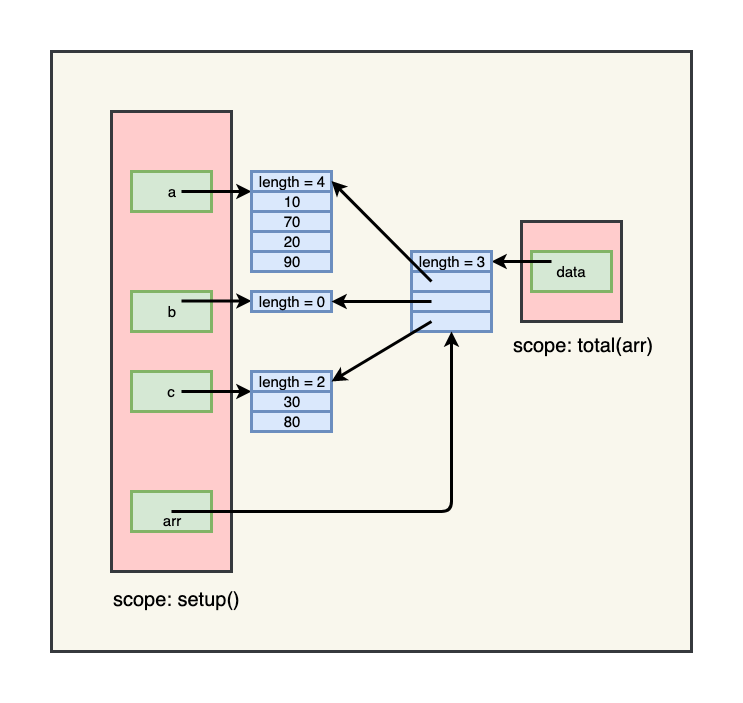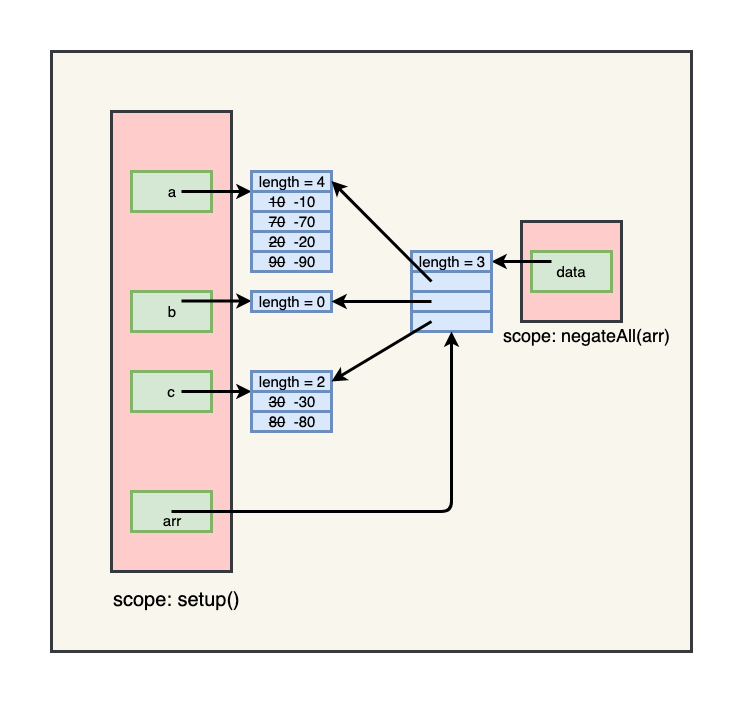Multi-dimensional arrays
Assumed Knowledge
Learning Outcomes
- Understand how to create, and operate on, multi-dimensional arrays.
Author: Gaurav Gupta
The biggest mistake people make while studying 2-dimensional arrays is visualizing them as rows and columns.

Stay with me for a bit and see why should you let go of the rows and columns approach and instead use the sets approach.
Let us go through basic arrays and build up to 2-dimensional arrays.
-
It’s critical to understand the concept of
referenceandinstance. In the following code,srcanddestare two references that refer to the same instance which is the collection of values 10, 70, 20, and 90 (and the length attribute is also tucked away somewhere).1 2
int[] src = {10, 70, 20, 90}; int[] dest = src;

In the following code, there are three references, each referring to its own instance.
1 2 3
int[] a = {10, 70}; int[] b = {20, 90, 30}; int[] c = {80};
-
An array can have ANY VALID type. So, the most generic syntax of an array is:
```java Type[] arrayName = new Type[size];
1
```
- An array is itself a data type.
-
So if
Typeisint[], we have:1
int[][] data = {a, b, c}; //since a, b, c are each int[]

datahas 3 items, each of typeint[]inside it.- First item of data (
data[0]) is of typeint[]and has 2 items (10 and 70), each of typeintinside it. - Second item of data (
data[1]) is of typeint[]and has 3 items (20, 90, and 30), each of typeintinside it. - Third item of data (
data[2]) is of typeint[]and has 1 item (80), each of typeintinside it.
Now, we can go through each item in data using:
1
2
3
for(int i=0; i < data.length; i++) {
//access to data[i] which is of type int[]
}
If it helps you understand better, you can copy the current array into a local variable.
1
2
3
for(int i=0; i < data.length; i++) {
int[] current = data[i]; //current is a reference copy of data[i]
}
Then we can go through each item of current as well!
1
2
3
4
5
6
7
for(int i=0; i < data.length; i++) {
int[] current = data[i]; //current is a reference copy of data[i]
for(int k=0; k < current.length; k++) { //I (as in Gaurav, not int i) like to use k instead of j
print(current[k]+" ");
}
println();
}
The above will output:
1
2
3
10 70
20 90 30
80
Now, if we back substitute current with data[i], we get,
1
2
3
4
5
6
for(int i=0; i < data.length; i++) {
for(int k=0; k < data[i].length; k++) {
print(data[i][k]+" ");
}
println();
}
- If we need to find the total of all the items:
1
2
3
4
5
6
int total = 0;
for(int i=0; i < data.length; i++) {
for(int k=0; k < data[i].length; k++) {
total+=data[i][k];
}
}
- If we need to find the highest value:
1
2
3
4
5
6
7
8
int highest = Integer.MIN_VALUE; //to override if and only if required
for(int i=0; i < data.length; i++) {
for(int k=0; k < data[i].length; k++) {
if(data[i][k] > highest) {
highest = data[i][k];
}
}
}
Note, you can also create the same array as:
1
int[][] data = { {10, 70}, {20, 90, 30}, {80}} ;
So… why did I say that you shouldn’t think of 2-d arrays in terms of rows and columns? Because, as you see, not each sub-array needs to have the same number of items. Even if you ignore that (which you shouldn’t), while the above is easy to visualize, the following is not:
1
2
// assuming data is a two-dimensional array (int[][])
int[][][] mega = { data, { {50}, {30, 60} } };
If anyone still insists on thinking of 2-dimensional arrays as rows and columns, ask them to explain a 4-dimensional array to you, without both your heads exploding.
Example of passing a multi-dimensional array to a function
1
2
3
4
5
6
7
8
9
10
11
12
13
14
15
16
17
18
void setup() {
int[] a = {10, 70, 20, 90};
int[] b = {};
int[] c = {30, 80};
int[][] arr = {a, b, c};
int sum = total(arr);
println(sum);
}
int total(int[][] data) {
int result = 0;
for(int i=0; i < data.length; i++) {
for(int k=0; k < data[i].length; k++) {
result+=data[i][k];
}
}
return result;
}

Example of modiying contents of a multi-dimensional array in a function
1
2
3
4
5
6
7
8
9
10
11
12
13
14
15
16
17
void setup() {
int[] a = {10, 70, 20, 90};
int[] b = {};
int[] c = {30, 80};
int[][] arr = {a, b, c};
negateAll(arr);
//arr becomes { {-10, -70, -20, -90}, {}, {-30, -80} }
}
void negateAll(int[][] data) {
int result = 0;
for(int i=0; i < data.length; i++) {
for(int k=0; k < data[i].length; k++) {
data[i][k]*=-1;
}
}
}

Advanced question 1
What is the state of the array arr inside setup() after reset1 is called?
1
2
3
4
5
6
7
8
9
10
11
12
13
14
15
16
17
void setup() {
int[] a = {10, 70, 20, 90};
int[] b = {};
int[] c = {30, 80};
int[][] arr = {a, b, c};
reset1(arr);
//what are the contents of arr here?
}
void reset1(int[][] data) {
int result = 0;
for(int i=0; i < data.length; i++) {
for(k=0; k < data[i].length; k++) {
data[i][k] = 0;
}
}
}
Advanced question 2
What is the state of the array arr inside setup() after reset2 is called?
1
2
3
4
5
6
7
8
9
10
11
12
13
14
15
void setup() {
int[] a = {10, 70, 20, 90};
int[] b = {};
int[] c = {30, 80};
int[][] arr = {a, b, c};
reset2(arr);
//what are the contents of arr here?
}
void reset2(int[][] data) {
int result = 0;
for(int i=0; i < data.length; i++) {
data[i] = new int[3];
}
}
Advanced question 3
What is the state of the array arr inside setup() after reset3 is called?
1
2
3
4
5
6
7
8
9
10
11
12
void setup() {
int[] a = {10, 70, 20, 90};
int[] b = {};
int[] c = {30, 80};
int[][] arr = {a, b, c};
reset3(arr);
//what are the contents of arr here?
}
void reset3(int[][] data) {
data = new int[][]{ {0, 0}, {0, 0} };
}